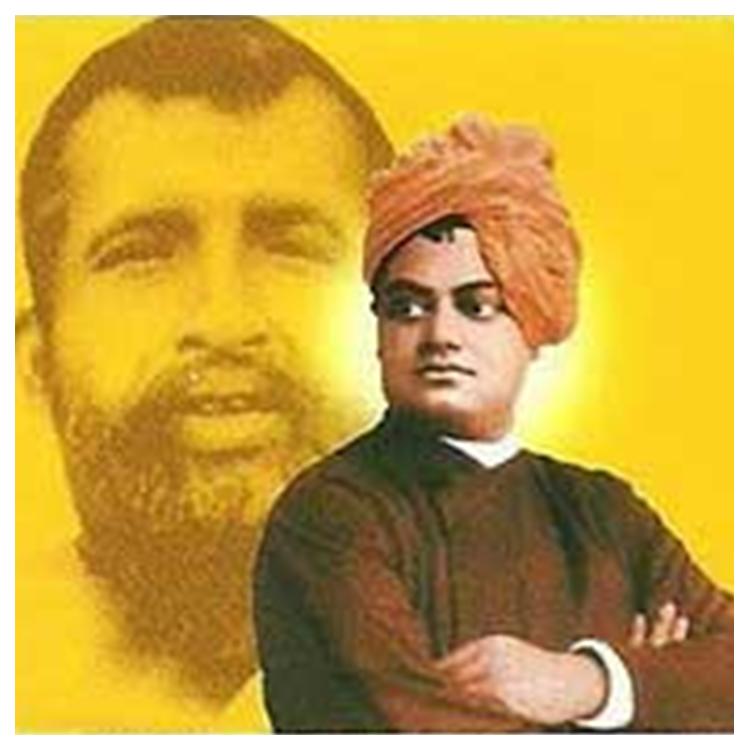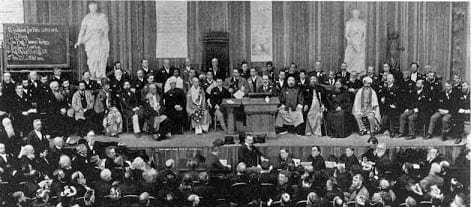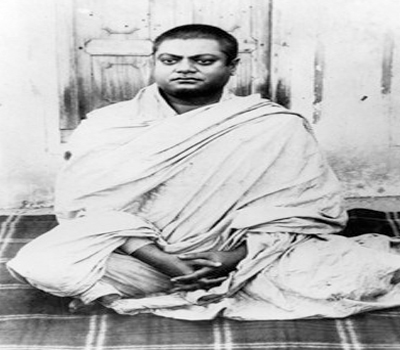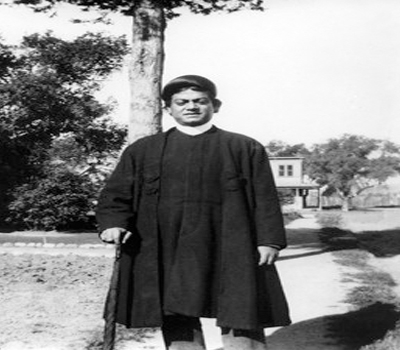The Problematique
Without going into the existing debate on the reliability of the sources for this tradition, this essay relies on two conventional sources: (i) the Sri Sri Ramakrishna Kathamrita by M, translated into English as The Gospel of Sri Ramakrishna; and (ii) The Complete Works of Swami Vivekananda. This choice is guided by the understanding that the content of these basic sources has been only partly understood, misunderstood outside their context and the larger picture of teachings, or even misrepresented by some scholars. By relying on these sources it is possible to get a different picture compared to what has been understood by scholars so far.
Prologue: Three Attitudes of Mind
You have no doubt heard the story of the chameleon. A man entered a wood and saw a chameleon on a tree. He reported to his friends, ‘I have seen a red lizard.’ He was firmly convinced that it was nothing but red. Another person, after visiting the tree, said, ‘I have seen a green lizard.’ He was firmly convinced that it was nothing but green. But the man who lived under the tree said: ‘What both of you have said is true. But the fact is that the creature is sometimes red, sometimes green, sometimes yellow, and sometimes has no colour at all.’ 9
But, my dear sir, I am in a peculiar state of mind. My mind constantly descends from the Absolute to the Relative, and again ascends from the Relative to the Absolute. … The manifold has come from the One alone, the Relative from the Absolute. There is a state of consciousness where the many disappears, and the One, as well; for the many must exist as long as the One exists. Brahman is without comparison. … Again, when God changes the state of my mind, when He brings my mind down to the plane of the Relative, I perceive that it is He who has become all these—the Creator, maya, the living beings, and the universe. Again, sometimes he shows me that He has created the universe and all living beings. He is the Master, and the universe His garden (307).
When Prahlada forgot himself, he found neither the universe nor its cause; all was to him one Infinite, undifferentiated by name and form; but as soon as he remembered that he was Prahlada, there was the universe before him and with it the Lord of the universe … So it was with the blessed Gopis. So long as they had lost sense of their own personal identity and individuality, they were all Krishnas, and when they began again to think of Him as the One to be worshipped, then they were Gopis again, and immediately—‘Unto them appeared Krishna with a smile on His lotus face, clad in yellow robes and having garlands on, the embodied conqueror (in beauty) of the god of love.’10
It is the Man [ Jesus Christ] who said, ‘I and my Father are one,’ whose power has descended unto millions … we know that the same Man, because he was a non-dualist, was merciful to others. To the masses who could not conceive of anything higher than a Personal God, he said, ‘Pray to your Father in heaven.’ To others who could grasp a higher idea, he said, ‘I am the vine, ye are the branches,’ but to his disciples to whom he revealed himself more fully, he proclaimed the highest truth, ‘I and my Father are one’ (2.142–3).
Jnana and Vijnana
Here I can only lay before you what the Vedanta seeks to teach, and that is the deification of the world. The Vedanta does not in reality denounce the world. The ideal of renunciation nowhere attains such a height as in the teachings of the Vedanta. But, at the same time, dry suicidal advice is not intended; it really means deification of the world—giving up the world as we think of it, as we know it, as it appears to us—and to know what it really is. Deify it; it is God alone. We read at the commencement of one of the oldest of the Upanishads, ‘What ever exists in this universe is to be covered with the Lord.’
We have to cover everything with the Lord Himself, not by a false sort of optimism, not by blinding our eyes to the evil, but by really seeing God in everything. Thus we have to give up the world, and when the world is given up, what remains? God. What is meant? You can have your wife; it does not mean that you are to abandon her, but that you are to see God in the wife. Give up your children; what does that mean? To turn them out of doors, as some human brutes do in every country? Certainly not. That is diabolism; it is not religion. But see God in your children. So, in everything. In life and in death, in happiness and in misery, the Lord is equally present. The whole world is full of the Lord. Open your eyes and see Him.12
We have to go through the negation, and then the positive side will begin. We have to give up ignorance and all that is false, and then truth will begin to reveal itself to us. When we have grasped the truth, things which we gave up at first will take new shape and form, will appear to us in a new light, and become deified. They will have become sublimated, and then we shall understand them in their true light. But to understand them, we have first to get a glimpse of truth; we must give them up at first, and then we get them back again, deified.14
Sri Ramakrishna reported that once Keshab Sen, Pratap Mazumdar and others said to him: ‘Sir, we follow the ideal of King Janaka’ (626). Sri Ramakrisha replied: ‘Mere words don’t make a King Janaka. How many austerities King Janaka first had to perform in solitude—standing on his head, and so on! Do something first; then you may become a King Janaka’ (626). He also said elsewhere: ‘One cannot be a King Janaka all of a sudden. Janaka at first practised much austerity in solitude’ (139).
Jnana and Bhakti
The Jnanis hold Bhakti to be an instrument of liberation, the Bhaktas look upon it both as the instrument and the thing to be attained. To my mind this is a distinction without much difference. In fact, Bhakti, when used as an instrument, really means a lower form of worship, and the higher form becomes inseparable from the lower form of realisation at a later stage. Each seems to lay a great stress upon his own peculiar method of worship, forgetting that with perfect love true knowledge is bound to come even unsought, and that from perfect knowledge true love is inseparable (3.34).
Like his master, Swamiji believed that the ‘one great advantage of Bhakti is that it is the easiest and the most natural way to reach the divine end in view.’25 The sheer naturalness of the path of bhakti makes all worldly desires fall off as the dry scales of a snake. As Swamiji states: ‘Love concentrates all the power of the will without effort’ (7.44). Furthermore, ‘Bhakti is not destructive; it teaches that all our faculties may become means to reach salvation. We must turn them all towards God and give to Him that love which is usually wasted on the fleeting objects of sense’ (7.83). This clearly reminds us of Sri Ramakrishna’s advice to divert our desires and passions towards God, thereby sublimating them. The swami was also aware of the difficulty of jnana yoga for the lay person:
Talk of reason! Very few people reason, indeed. You hear a man say, ‘Oh, I don’t like to believe in anything ; I don’t like to grope through darkness. I must reason.’ And so he reasons. But when reason smashes to pieces things that he hugs unto his breast, he says, ‘No more! This reasoning is all right until it breaks my ideals. Stop there!’ That man would never be a Jnani. That man will carry his bondage all his life and his lives to come. Again and again he will come under the power of death. Such men are not made for Jnana. There are other methods for them—such as Bhakti Yoga, Karma Yoga, or Raja Yoga—but not Jnana Yoga (9.215).
Though all religions have taught ethical precepts, such as, ‘Do not kill, do not injure; love your neighbour as yourself,’ etc., yet none of these has given the reason. Why should I not injure my neighbour? To this question there was no satisfactory or conclusive answer forthcoming, until it was evolved by the metaphysical speculations of the Hindus who could not rest satisfied with mere dogmas. So the Hindus say that this Atman is absolute and all-pervading, therefore infinite. There cannot be two infinites, for they would limit each other and would become finite. Also each individual soul is a part and parcel of that Universal Soul, which is infinite. Therefore in injuring his neighbour, the individual actually injures himself. This is the basic metaphysical truth underlying all ethical codes (1.384–5).
Not just jnana yoga, but all the four yogas are premised on this reason. Advaita is not the antithesis of bhakti. A personal God is perfectly explicable within the framework of Advaita as ‘the highest possible reading of the Absolute by the human mind’ (3.37). Again, after bhaktas realize God, they know God dwells inside all, including oneself. As Sri Ramakrishna said: ‘Most advanced devotees say that He Himself has become all this—the twenty-four cosmic principles, the universe, and all living beings.’26 The Holy Mother explained: ‘When one attains true knowledge, God Himself ceases to exist separately. One calls upon the eternal Mother and in the end finds Her in all creation. Everything then becomes One. That is all.’ 27 Sri Ramakrishna gave the example of Prahlada, the quintessential bhakta, to illustrate the Advaitic point that Hari dwells in all. He explained:
There are three kinds of devotees: superior, me-diocre, and inferior. The inferior devotee says, ‘God is out there.’ According to him God is different From His creation. The mediocre devotee says: ‘God is the Antaryami, the Inner Guide. God dwells in everyone’s heart.’ The mediocre devotee sees God in the heart. But the superior devotee sees that God alone has become everything ; He alone has become the twenty-four cosmic principles. He finds that everything, above and below, is filled with God. Read the Gita, the Bhagavata, and the Vedanta, and you will understand all this. Is not God in His creation? 28
Some scholars have approached this issue from a different perspective, distorting evidence and putting forth flimsy arguments based on superficial understanding. N P Sil has misconstrued Swamiji’s apparent reservations about the dissemination of the Radha-Krishna ideal as his sharp divergence from his guru. Swamiji’s statement in the concerned letter written to Swami Ramakrishnanand a and cited by Sil was in the context of a particular devotee, Biligiri Iyengar, a worshipper of Rama. The full citation is: ‘There is not the least necessity for teaching the divine Love of Radha and Krishna. Teach them pure devotion to Sita-Ram and Hara-Parvati. See that no mistake is made in this respect. Remember that the episodes of the divine relationship between Radha and Krishna are quite unsuitable for young minds. Specially Biligiri and other followers of Ramanujacharya are worshippers of Rama; so see to it that their innate attitude of pure devotion is never disturbed.’31
Swamiji has said, ‘A little awakening of the Kundalini is dangerous.’ Unless the Kundalini rises to the higher planes, lust, anger, and other low passions become very powerful. That is why the Vaishnava practices as a lover or friend are dangerous. Constantly dwelling on the love-relations between Shri Krishna and Shri Radha, they cannot control their lust and are degraded. I know of one who practised this way for a long time, but afterwards married a bad woman. One, therefore, should not in the beginning study books on Shri Krishna’s love-relations with the Gopis. 35






Leave A Comment
You must be logged in to post a comment.